| Author |
 Topic Topic  |
|
w2m
   
USA
1990 Posts |
 Posted - Mar 29 2016 : 12:06:13 Posted - Mar 29 2016 : 12:06:13


|
Fast Brush Painting With IEBitmap Canvas And Alpha Channel Demo
by William Miller/Adirondack
Full Source
Compiled with Delphi Seattle, but is expected to compile with Delphi 2010 or higher.
Price: Free
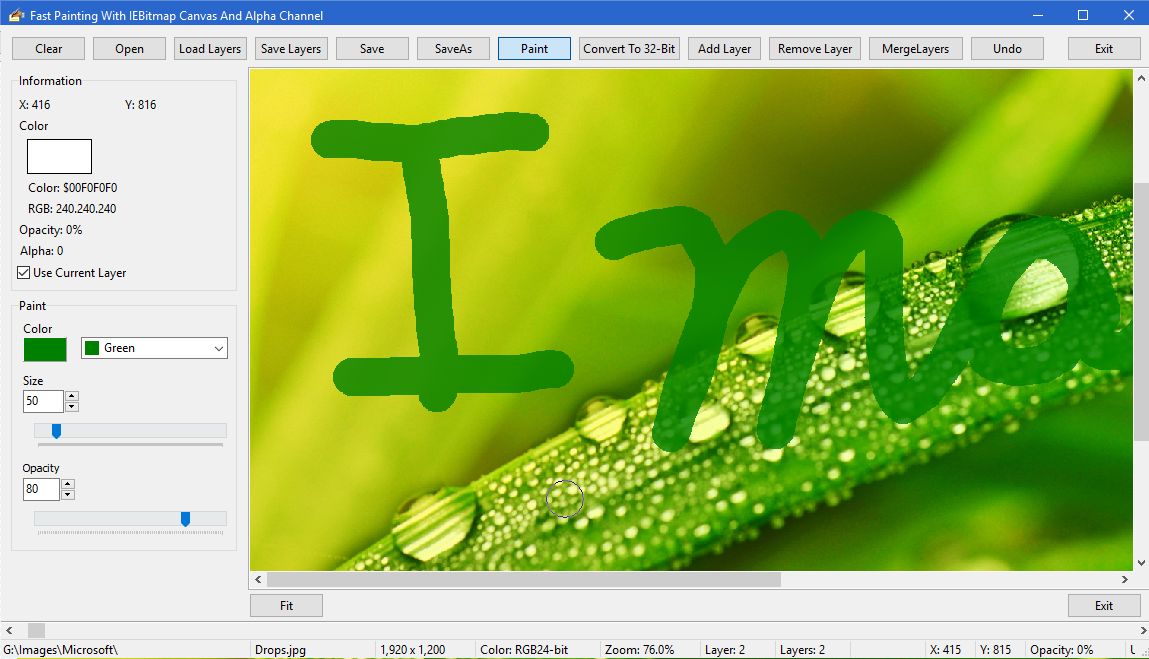
This demo shows how to do fast "brush" painting with IEBitmap, AlphaChannel and GDICanvas. The demo does not use a traditional "brush". Previous brush drawing demos using GDIPlus all exhibiit slow brush painting that produce intermittent gaps when painting because of the inherent slow speed of TIECanvas drawing speed. This technique has been optimized as much as possible and produces very fast drawing with a smooth continuous brush that can be used for things such as signing signatures on documents, filling information on forms or basic brush painting.
Download: attach/w2m/201632912942_PaintBrush.zip
62.74 KB
Bill Miller
Adirondack Software & Graphics
Email: w2m@hughes.net
EBook: http://www.imageen.com/ebook/
Custom Commercial ImageEn Development
|
 |
|
|
spetric
  
Croatia
308 Posts |
 Posted - May 06 2016 : 07:55:59 Posted - May 06 2016 : 07:55:59


|
Scale Invariant Feature Transform (C++ XE5)
Implementation is done using FastSift console application:
https://sourceforge.net/projects/libsift/
1. Load source (template) image.
2. Calculate source SIFT key features*.
3. Load target image.
4. Calculate target SIFT key features*.
5. Calculate source/target matching.
6. Adjust distance threshold.
* = if source/target key features are not calculated they will be calculated
in step 5.
Note: matching algorithm is little bit naive: O(n^2). Faster approach is to implement k-d tree algorithm: O(n*log(n)).
https://github.com/jtsiomb/kdtree
Figure 1: source image key features. Each circle radius depends on feature scale
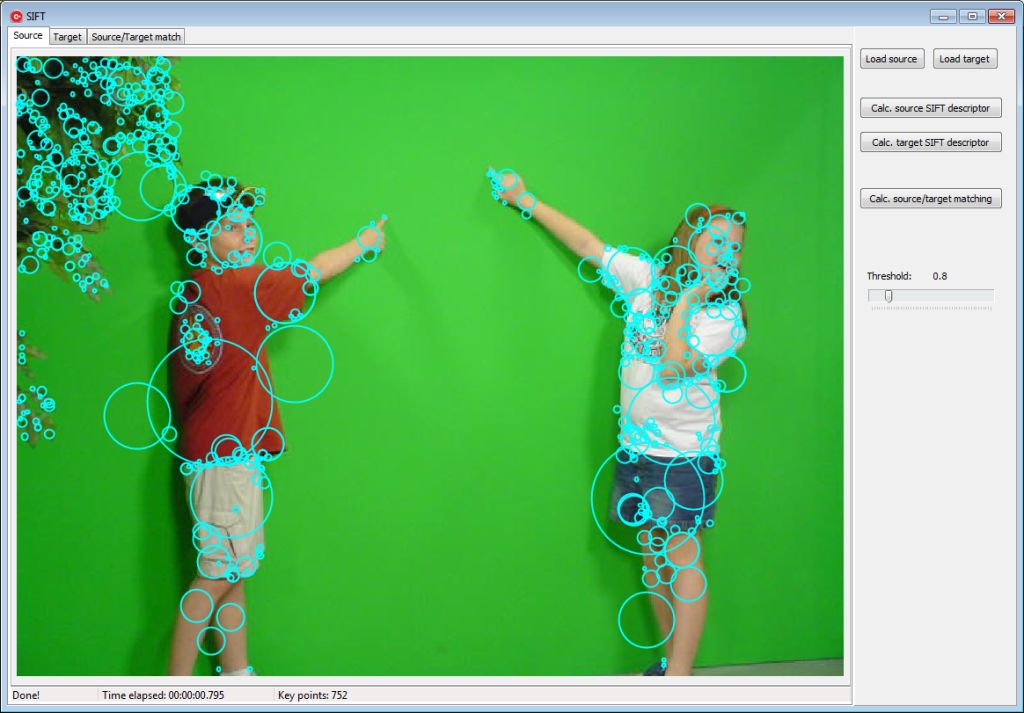
Figure 2: matching lines between source and target images with given threshold
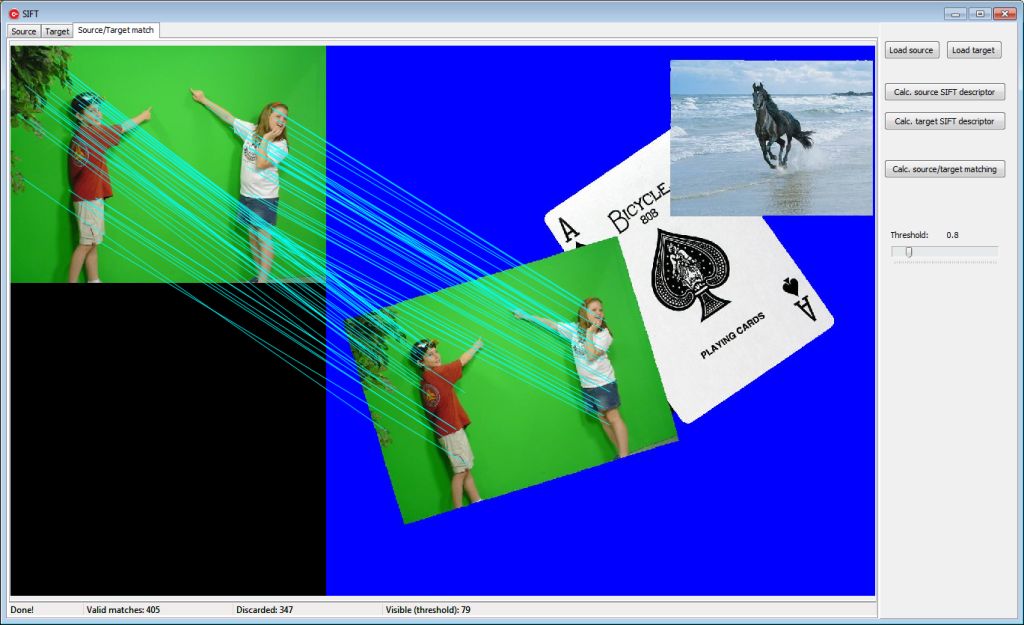
Binaries and source code:
attach/spetric/20165675412_ien_sift.zip
3062.74 KB
Note: any suggestions and prog. corrections are welcomed.
Thanks.
Edit: console program requires grayscale pgm image for calculation.
Program IenSift accepts 24-bit images, which are converted to grayscale and saved as pgm (source.pgm, target.pgm). IenSift invokes console program and
it calculates key features/descriptors and saves them in respectable .kds files. Files (.kds) are parsed and structure (record) is filled with key/descriptor data.
|
 |
|
|
xequte
    
38790 Posts |
|
|
spetric
  
Croatia
308 Posts |
 Posted - May 09 2016 : 01:39:01 Posted - May 09 2016 : 01:39:01


|
Hi Nigel,
Maybe it's a bug in demo program. On my side it works Ok.
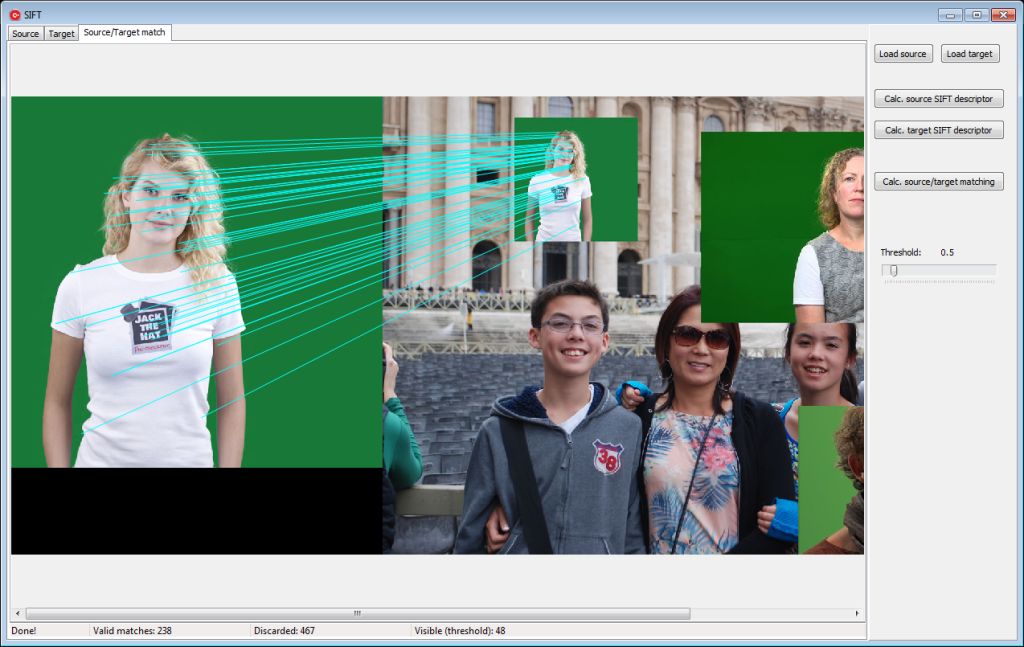
Here are steps for this test:
1. start IenSift.exe
2. Load source image
3. Load target image
4. Click button "Calc. source/target matching"
5. Adjust threshold slider to 0.5
If it does not work, the problem is probably in paths inside the prog.
I will test the demo in clean virtual Windows Xp/7 to see if it works correctly.
EDIT: Got it! It does not work on clean Win xp/7 machines:
Dependent Assembly Microsoft.VC80.OpenMP,processorArchitecture="x86",publicKeyToken="1fc8b3b9a1e18e3b",type="win32",version="8.0.50727.4053" could not be found.
Console app requires MS Visual C++ redistributable package. As I do have MSVC redistributable package on my PC it worked correctly. More precisely, it requires (VC80) Microsoft Visual C++ 2005 Service Pack 1 Redistributable Package.
In "fast sift" description clearly stands: "A cross-platform library that computes fast and accurate SIFT image features. libsiftfast provides Octave/Matlab scripts, a command line interface, and a python interface (siftfastpy). Optimized with SIMD instructions and OpenMP.
I thought that an author packed OpenMP APIs in siftfast.dll, but I was utterly wrong...what a pity. Too much dependencies.
|
 |
|
|
xequte
    
38790 Posts |
 Posted - May 09 2016 : 02:57:10 Posted - May 09 2016 : 02:57:10


|
Hi
Yes, that's what I tried, so I suspect it is related to it looking for the two associated files in a specific path.
Nigel
Xequte Software
www.xequte.com
nigel@xequte.com
|
 |
|
|
spetric
  
Croatia
308 Posts |
 Posted - May 09 2016 : 04:04:12 Posted - May 09 2016 : 04:04:12


|
Hi Nigel,
I have put the answer to the problem in my previous post. The problem is in console application dependencies, which I overlooked.
When I tried it on clean Win xp and 7 installation, the number of detected key-points was 0, which led to console app., that led to MSVC redistributable package dependencies.
It seams that using ready-made console app was not a bright idea, although the app/library is highly optimized.
Edit: I've found a decent source code in plane ANSI C (w/o external dependencies). I'll try to implement it in XE5. |
 |
|
|
w2m
   
USA
1990 Posts |
 Posted - May 15 2016 : 13:33:35 Posted - May 15 2016 : 13:33:35


|
Hi Roy,
Do you have a demo of the curves tool that will compile and run with Win64? It needs some changes to work with Win64.
I am using the demo posted at the ImageEn User demos.
Win32
Inc(integer(iRGBArray), SFill);
Win65
Inc(pByte(iRGBArray), SFill);
Plus other procedures need modifications or exceptions are produced.
Also please send me your latest email address.
Thanks,
Bill Miller
Adirondack Software & Graphics
Email: w2m@hughes.net
EBook: http://www.imageen.com/ebook/
Custom Commercial ImageEn Development |
 |
|
|
w2m
   
USA
1990 Posts |
 Posted - May 19 2016 : 11:09:04 Posted - May 19 2016 : 11:09:04


|
Demo - How to use Annotations With TImageEnMView with TImageEnVect
by William Miller/Adirondack
Full Source
Compiled with Delphi Seattle, but is expected to compile with Delphi 2010 or higher. Requires ImageEn Version 6.3.
Includes Source Code and EXE
Price: Free
Frame 1
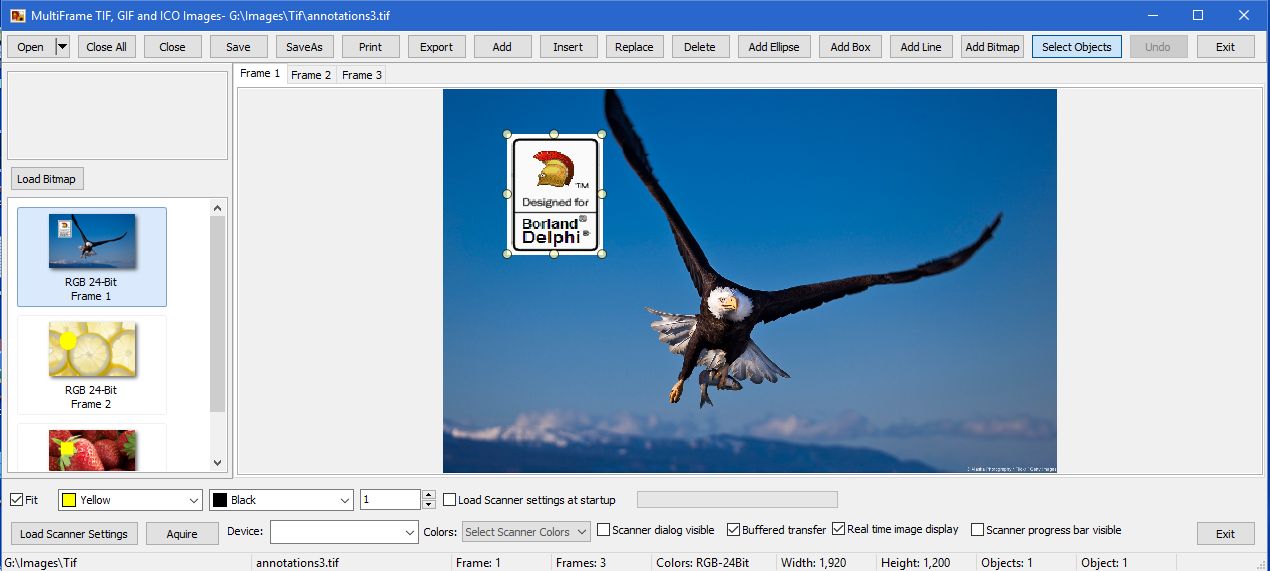
Frame 2
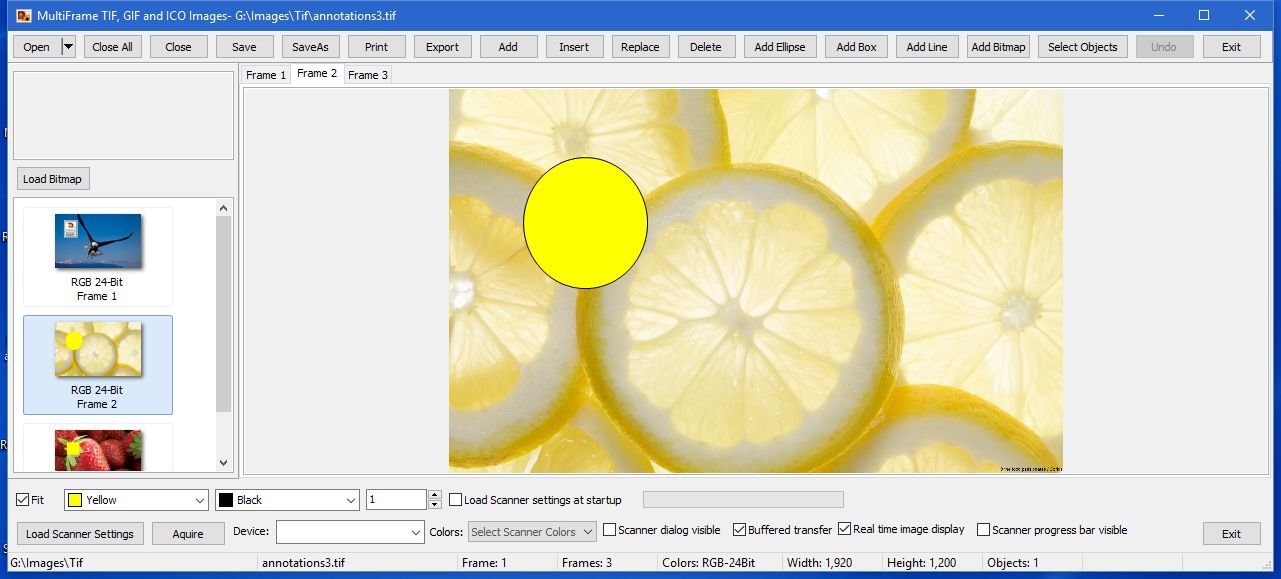
Frame 3
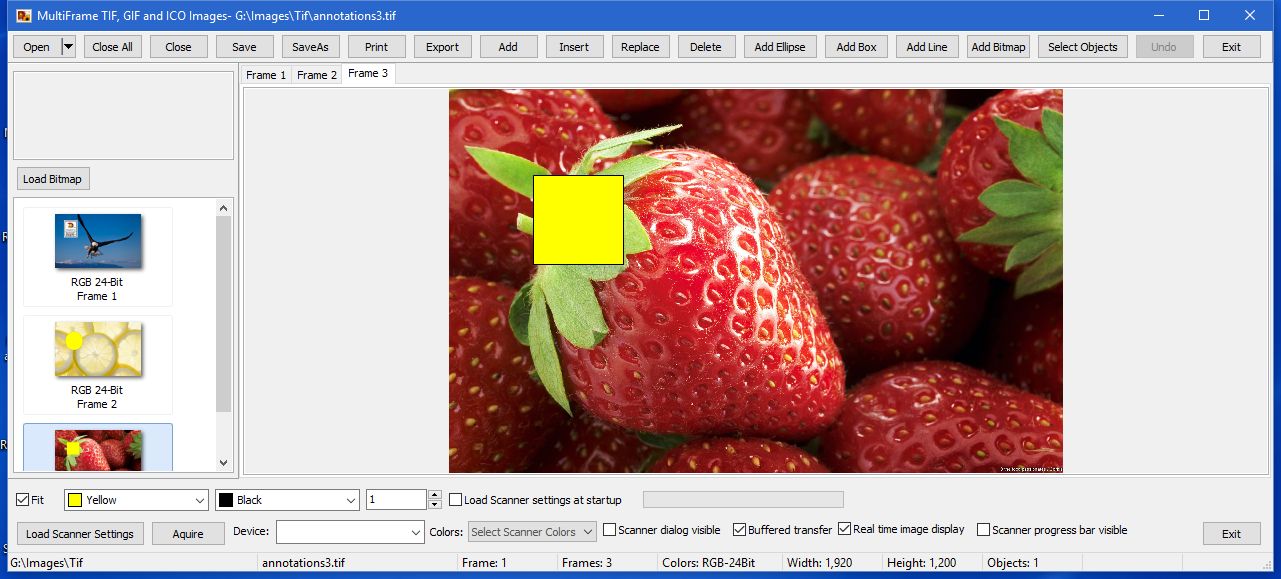
Print Preview Dialog
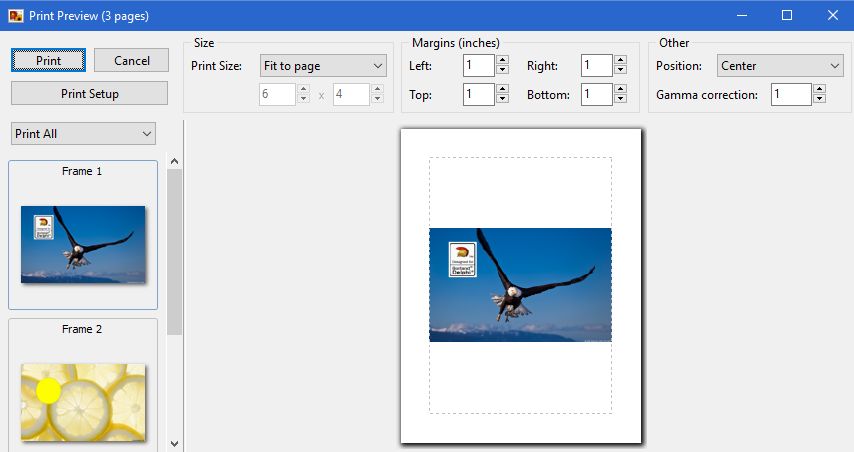
Printer Result
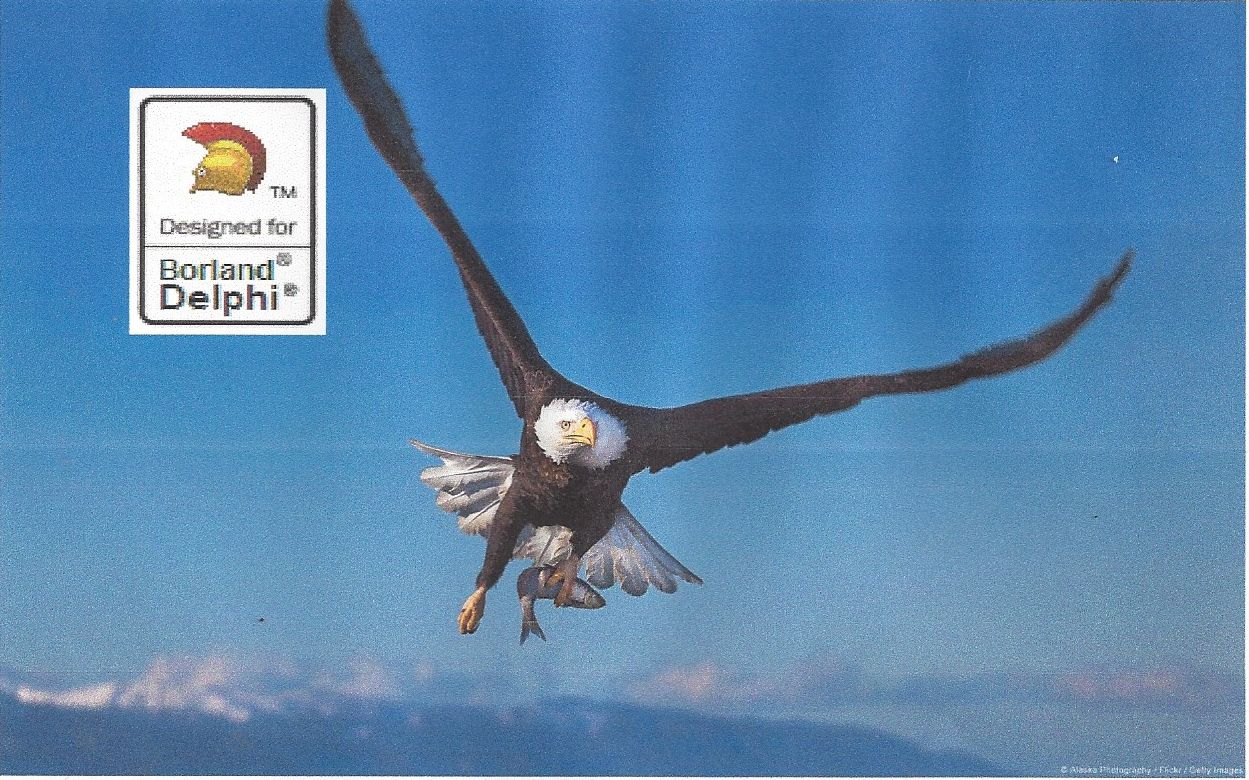
This demo may be important for many developers of ImageEn who work with multiframe tiff file with objects. The demo shows one way to use annotations with TImageEnMView with TImageEnVect to load, save, print images and objects. When TImageEnMView.AnnotationsVisible is enabled, TOParams.ImageEnAnnot ImageEn annotations of the image are shown on the thumbnail.
Notes:
- This property has no effect if TImageEnMView.StoreType is ietThumb. It is only supported by ietNormal and ietFastThumb.
- This will slow performance so is only recommended for annotation-specific applications.}
Key code:
ImageEnMView1.AnnotationsVisible := True; { This is important }
{ Remove all vectorial objects from TIEImageEnAnnot - Important }
ImageEnMView1.MIO.Params[ImageEnMView1.SelectedImage].ImageEnAnnot.Clear;
{ Copy vectorial objects from a TImageEnVect object to TImageEnMView - Important }
ImageEnMView1.MIO.Params[ImageEnMView1.SelectedImage]
.ImageEnAnnot.CopyFromTImageEnVect(ImageEnVect);
if ImageEnMView1.MIO.Params[idx].ImageEnAnnot.ObjectsCount <>
ImageEnVect.ObjectsCount then
{ Copy vectorial objects in TIEImageEnAnnot into the specified TImageEnVect - Important}
ImageEnMView1.MIO.Params[ImageEnMView1.SelectedImage]
.ImageEnAnnot.CopyToTImageEnVect(ImageEnVect);
Download: New Update
attach/w2m/2016519193249_Multiframe.zip
2913.88 KB
This demo gets around the need to copyobjectstoback in order to print the image frames and the objects, which is really a nice feature.
I tested this for a while, but there maybe some bugs so if you have a problem let me know. I did test creating a new multiframe tiff file, loading multiframe tif files with objects, saving the multiframe tiff file, and printing all frames or the selected frame. I also tested the scanning with my scanner.
The only known bug is that objects do not preview at all with some 1-bit tiff files.
Bill Miller
Adirondack Software & Graphics
Email: w2m@hughes.net
EBook: http://www.imageen.com/ebook/
Custom Commercial ImageEn Development |
 |
|
|
klausdoege
  
Germany
389 Posts |
 Posted - Sep 10 2016 : 02:51:31 Posted - Sep 10 2016 : 02:51:31


|
Hello spetric,
for spetric/20165675412_ien_sift.zip,
is there a delphi source available ?
And for the 20162158835_seam_carving too ?
Regards
Klaus
Klaus
www.klausdoege.de |
 |
|
|
xequte
    
38790 Posts |
|
|
klausdoege
  
Germany
389 Posts |
 Posted - Sep 12 2016 : 13:00:12 Posted - Sep 12 2016 : 13:00:12


|
Hello Nigel,
this is a pity, but in my age I will learn no more C++.
Klaus
www.klausdoege.de |
 |
|
|
spetric
  
Croatia
308 Posts |
 Posted - Oct 07 2016 : 04:51:27 Posted - Oct 07 2016 : 04:51:27


|
Hi Klaus,
Sorry for delayed answer (I was really busy last few months).
Regarding SIFT, I have managed to compile source code I found on IPOL journal and it works quite well.
It does not depend on any runtime libraries. I'll do some more testing and after that
I'll create a library (static and DLL) and upload it together with demo program.
So, it will be possible to use it from Delphi.
|
 |
|
|
spetric
  
Croatia
308 Posts |
 Posted - Oct 11 2016 : 16:41:19 Posted - Oct 11 2016 : 16:41:19


|
Done!
Here is a DLL and demo application described in IPOL Journal:
http://www.ipol.im/pub/art/2012/mmm-oh/
Source code in C is freely available and I wrapped it up in DLL so it can be used from Delphi. All parameters are described in article on link above and all necessary structures and DLL entries are described in Orsa.h header that goes with this DLL.
Demo application and Orsa.dll do not require any obscure runtime libraries.
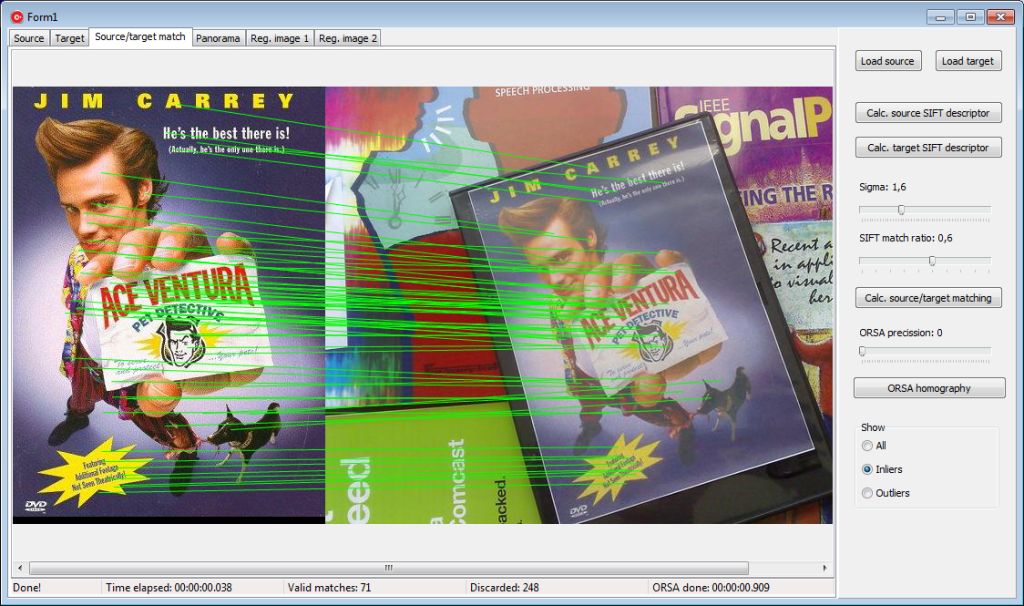
Usage: first load source (sample) and target (master) image.
Then you can click Calc. source SIFT descriptor, Calc. target SIFT descriptor and then click Calc. source/target matching or you can click immediately Calc. source/target matching and program will first calculate source and target descriptors and then calculate source/target matching.
After source/target matching is calculated, you can click Orsa homography to run RANSAC/ORSA homography estimation.
There are three output images: Panorama, Registered image 1 and Registered image 2 (same as in demo on IPOL jurnal pages). If two input images are of "panoramic" sort they will be stitched together in panorama output.
Here is demo application (with source code) and DLL (without source code, source code is really messy)
attach/spetric/2016101116368_orsa_distrib.zip
6062.58 KB
Known bugs: you can select background color to fill output images (panorama, reg1 and reg2), but method fill in template class does not work correctly, so use either clWhite or clBlack. It's some obscure template class and I need to carefully examine the code.
Note: Input bitmaps must be of type ie24RGB. Alpha channel is not supported, but I'll try to implement it in future.
Note: To call DLL from Delphi you only need to convert Orsa.h header file to Pascal. There are only structs (records) and DLL entry typedefs.
Have fun,
Siniša
Edit1: orsaIntersection structure in Orsa.h gives intersection box, i.e. a box that encloses a part where two images intersect. It's useful if you want to blend images reg1 and reg2 to avoid visible stitches. Intersection box coordinates are based on target image.
Note: Homography is now included in ImageEn+IEVision. See the demo:
\Demos\IEVision\ImageAlignment\ImageAlignment.dpr |
 |
|
|
spetric
  
Croatia
308 Posts |
 Posted - Oct 13 2016 : 16:30:29 Posted - Oct 13 2016 : 16:30:29


|
I've tried to call DLL from Delphi, but it crashes, because it's not possible to pass classes (TIEBitmap) across module boundaries, except if
it's linked with dynamic RTL/VCL. In C++ it works flawless.
So, I've modified a DLL and all entries are of the same type. Only arguments
passed are two structures. All images are passed as an array of byte pointers to TIEBitmap scanlines.
Although I'm very clumsy with Delphi, I've managed to make SIFT/ORSA work (hurrah).
Beside that, any reference to VCLs are removed from DLL and it's size shrank to 1.4MB.
So, here is again SIFT/ORSA DLL (2.0) with demo exe in C++ (with source code), but this time with demo program in Delphi (source code only). It can load image (24 bit) and calculate SIFT descriptors.
Orsa.h header file was converted to ORSA.PAS file using Dr.Bob's converter wizard and then adjusted by hand...now this was pain in the....
attach/spetric/2016101316245_orsa_20.zip
3596.59 KB
More experienced Delphi programmers can check Orsa.h vs ORSA.PAS and eventually finish Delphi project that I've started.
Have fun,
Siniša
Once again, output images (panorama, reg1 and reg2) are created the same way as in IPOL online demo. I don't like the way panorama, reg1 and reg2 are created:
output.width = max(source.width, target.width)
output.height = max(source.height, target.height)
and then all output images are translated according to center of the new image, but I didn't want to modify original program. If I decide to make some kind of image stitcher, I'll modify the way output images are created.
|
 |
|
|
xequte
    
38790 Posts |
 Posted - Oct 17 2016 : 17:16:36 Posted - Oct 17 2016 : 17:16:36


|
Nice job, Sinisa. It works very effectively.
I'll be playing with it more once I get on top of the mountain of emails that accumulated during my holiday.
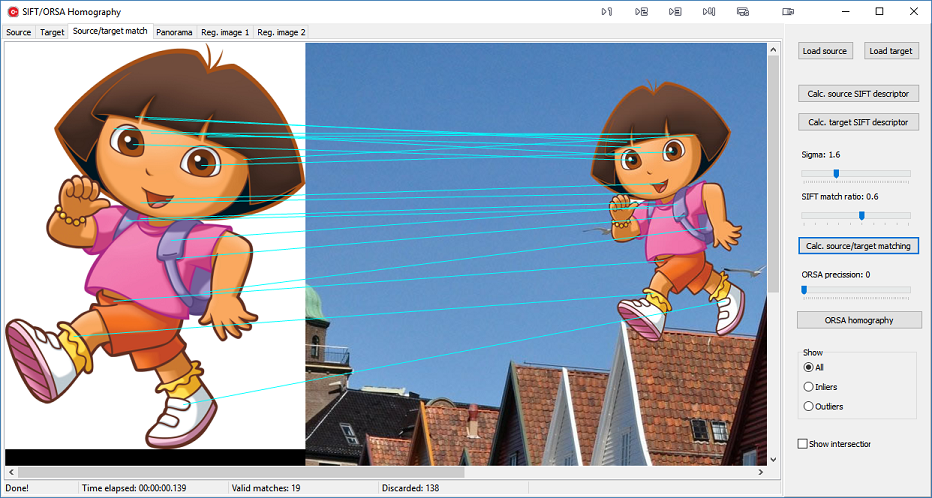
Note: Homography is now included in ImageEn+IEVision. See the demo:
\Demos\IEVision\ImageAlignment\ImageAlignment.dpr
Nigel
Xequte Software
www.xequte.com
nigel@xequte.com
|
 |
|
|
spetric
  
Croatia
308 Posts |
 Posted - Oct 26 2016 : 17:01:09 Posted - Oct 26 2016 : 17:01:09


|
Hi Nigel,
There is a bug in DLL: inliners and outliners internal vector lists were not cleared, so when you load new src/target image inliners/outliners vectors data were cumulated (original code is console application, so there wasn't need for any clearing). Beside that I've added translate option (will the reg. images be translated to accommodate new "panorama" output or not). Translate option is added in structure/record (see orsa.pas).
Also, I've modified original image template so that color filling now works ok (I've set green color background in demo).
Here is the new DLL and demo prog. version:
attach/spetric/20161026165944_orsa_distrib.zip
3597.03 KB |
 |
|
|
spetric
  
Croatia
308 Posts |
 Posted - Nov 16 2016 : 16:46:31 Posted - Nov 16 2016 : 16:46:31


|
I'm rewriting my drawing engine (surface, geometry, drawing, filters, etc..) and here is a little "by product": a 2D Tessellation, including Voronoi diagram and Delaunay triangulation (including Gouraud shading). The source is in C++, but if there is substantial interest, I can pack complete engine (in it's present status) in DLL, so it can be called from Delphi.
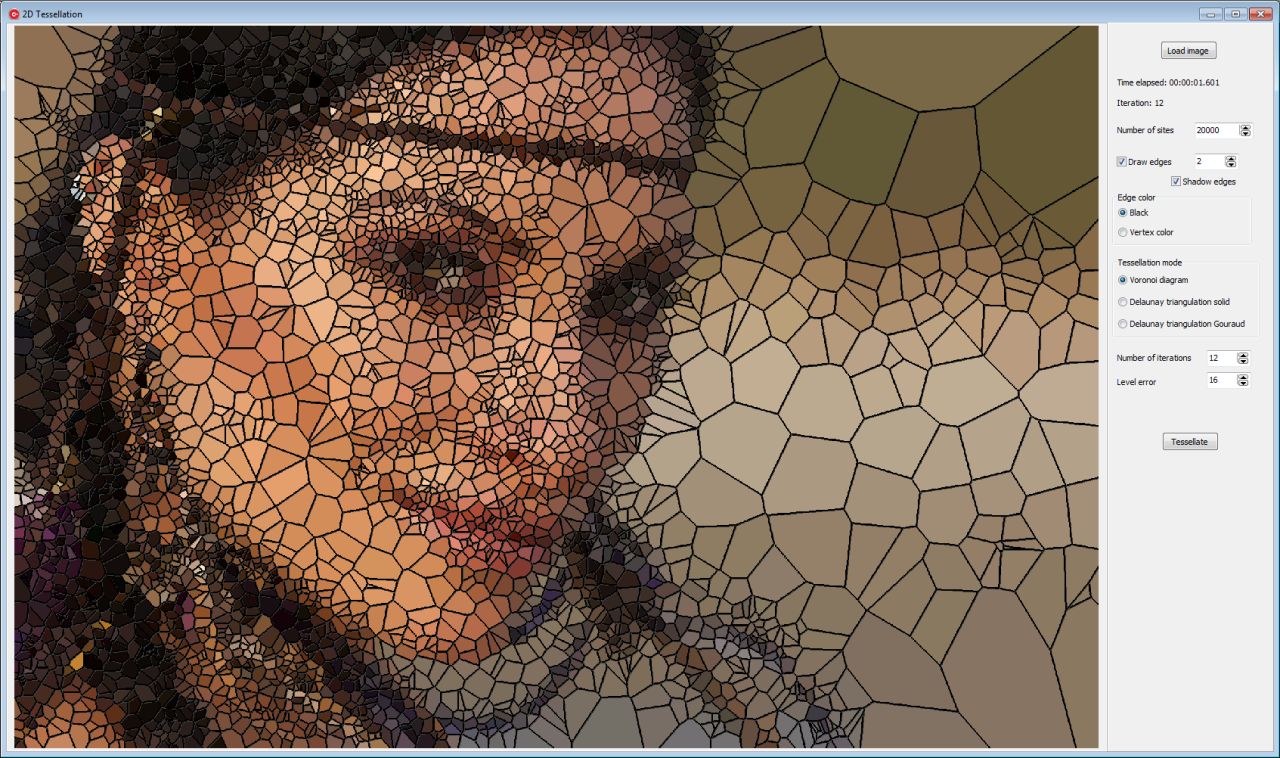
Here is demo and source code:
attach/spetric/20161116163042_voronoi_distrib.zip
3225.39 KB
Significant parameters:
Number of sites - number of sites in last iteration.
Number of iterations - number of sites are divided by two for each iteration. Tessellation is made from the first level (iteration with smallest number of sites) and goes upward (number of sites are now multiplied by two).
New sites are added and new tessellation is performed.
Level error - for each level (iteration) every new site candidate, i.e. color (luminance) from previously tessellated image at x,y is compared to original image color (luminance) at x,y. if abs(siteLum - origPixelLum) is higher then given error, site is added, otherwise it's discarded. In such a way, areas with similar color are not tessellated (see the figure above - areas on the right side of the image).
NOTE: high number of iterations with high number of sites tend to be very slow (10 seconds and above).
Have fun,
Siniša
|
 |
|
|
xequte
    
38790 Posts |
 Posted - Nov 17 2016 : 20:00:55 Posted - Nov 17 2016 : 20:00:55


|
Hi Sinisa
Nice work. It gives some really cool effects. I did not notice any particular performance issues, even with large images.
Nigel
Xequte Software
www.xequte.com
nigel@xequte.com
|
 |
|
|
spetric
  
Croatia
308 Posts |
 Posted - Nov 18 2016 : 06:54:34 Posted - Nov 18 2016 : 06:54:34


|
Hi Nigel,
Glad you like it. However, it's little cumbersome, because when tessellation is performed, routine returns both voronoi edges and Delaunay triples, so there is no need to run it again and again when mode is changed or edges color is changed.
So, I've changed the logic and added few extra parameters:
1. Number of sites (end): number of sites in last iteration.
2. Number of sites (start): number of sites in first iteration.
3. Custom color: edge color can be picked from ColorBox.
4. Redraw: a button that performs various styles of output (once tessellation is done).
Iterations are simplified: first iteration is started with given sites number (2.) and for each subsequent iteration, number of possible sites is incremented until final sites number is reached (1.).
Also, I have added a possibility to save the image and fixed some bugs (Gouraud shading).
Here is the new version:
attach/spetric/2016111865312_voronoi_distrib.zip
3136.23 KB |
 |
|
|
klausdoege
  
Germany
389 Posts |
 Posted - Dec 13 2016 : 11:43:20 Posted - Dec 13 2016 : 11:43:20


|
Hi Spetric, this is a cool effect.
But how you now, i make all with delphi.
Is there a DLL available ?
regards
Klaus
Klaus
www.klausdoege.de |
 |
|
 Topic Topic  |
|